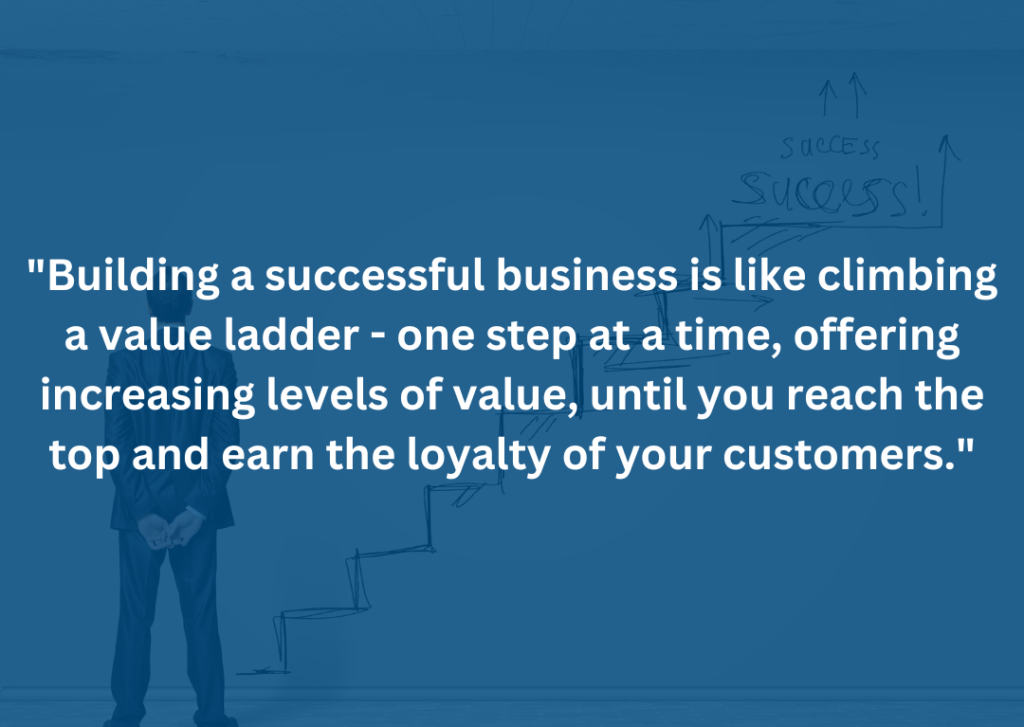Introduction
If you’re running a business, you’re probably always looking for ways to grow and expand your customer base. One powerful tool that can help you do that is a value ladder. A value ladder is a marketing strategy that involves offering different levels of value to your customers at different price points. By offering increasing levels of value, you can build loyalty and trust with your customers, which can lead to increased revenue over time.
In this article, we’ll take a closer look at what a value ladder is, how it works, and how you can create one for your business. We’ll also explore some common questions and concerns about value ladders and offer some tips for getting started.
What is a Value Ladder?
A value ladder is a marketing strategy that involves offering different levels of value to your customers at different price points. The idea is to start by offering something of relatively low value (and low cost) to your customers, and then gradually increase the value and price of your offerings as you build trust and loyalty with them.
Here’s an example of a value ladder for a business that sells fitness products:
- Free eBook on healthy eating and exercise
- $10/month subscription to a monthly workout plan
- $100 one-on-one coaching session
- $1,000 online course on fitness and nutrition
- $10,000 retreat with personal training and nutrition coaching
As you can see, each level of the ladder offers more value and is priced accordingly. The goal is to get customers to start at the bottom of the ladder and gradually work their way up, ultimately becoming high-value clients who are willing to pay top dollar for your services.
How Does a Value Ladder Work?
A value ladder works by providing increasing levels of value to your customers over time. When customers first come to your business, they may be hesitant to invest a lot of money in your products or services. However, if you offer them something of low cost and high value, they may be more likely to take the leap.
As customers become more familiar with your business and trust you more, they may be willing to invest more money in your offerings. By offering higher levels of value at higher price points, you can create a natural progression that encourages customers to continue investing in your business over time.
Additionally, a value ladder can help you build relationships with your customers. By offering personalized coaching or other high-value services, you can get to know your clients better and provide them with more tailored solutions. This can lead to increased loyalty and referrals, which can be invaluable for growing your business.
Creating Your Own Value Ladder
If you’re interested in creating your own value ladder, here are some steps to get started:
- Define your target audience: Who are your ideal customers, and what do they need or want from your business? Understanding your audience is key to creating a value ladder that resonates with them.
- Brainstorm value offerings: Think about what kinds of products or services you could offer at different price points. Consider what would be most valuable to your customers and what would help them achieve their goals.
- Determine price points: Once you have a list of potential offerings, determine the price points for each one. Keep in mind that each level of the ladder should offer more value than the previous level, so your pricing should reflect that.
- Test and refine: Once you have your value ladder mapped out, start testing it with customers. Pay attention to what works and what doesn’t, and refine your offers and pricing accordingly.
- Monitor and adjust: As you implement your value ladder, keep an eye on how well it’s working. Monitor customer feedback, sales data, and other metrics to see where you can make improvements. Adjust your offerings and prices as needed to keep your value ladder effective and profitable.

Common Questions About Value Ladders
Here are some common questions and concerns about value ladders, along with some answers:
1. Isn’t a value ladder just a way to upsell customers?
While a value ladder does involve offering customers higher-priced products or services over time, the goal is not just to make more money. Instead, the goal is to build trust and loyalty with customers by providing them with increasing levels of value. If customers feel like they are getting more value from your business over time, they will be more likely to stay with you and recommend you to others.
How does a value ladder work?
A value ladder works by providing increasing levels of value to your customers over time. When customers first come to your business, they may be hesitant to invest a lot of money in your products or services. However, if you offer them something of low cost and high value, they may be more likely to take the leap. As customers become more familiar with your business and trust you more, they may be willing to invest more money in your offerings. By offering higher levels of value at higher price points, you can create a natural progression that encourages customers to continue investing in your business over time.
2. Do I have to offer a free or low-cost product to start my value ladder?
While offering something of low cost and high value can be a great way to introduce customers to your business, it’s not strictly necessary. The key is to start with something that is easy for customers to say yes to and then gradually increase the value and price of your offerings as they become more familiar with your business.
3. How do I know what price points to set for my value ladder?
Setting prices for your value ladder can be tricky, as you need to balance providing enough value with making a profit. One strategy is to research your competitors and see what they are charging for similar products or services. You can also conduct surveys or focus groups to get feedback from your target audience on what they would be willing to pay.
4. Can I have more than one value ladder for different segments of my target audience?
Yes, you can have multiple value ladders for different segments of your target audience. For example, if you sell both fitness products and business coaching services, you may want to create separate value ladders for each. This can help you tailor your offerings and pricing to the specific needs and preferences of each audience.
How do I monitor the effectiveness of my value ladder?
You can monitor the effectiveness of your value ladder by tracking customer feedback, sales data, and other metrics. Keep an eye on which products or services are selling well and which ones are not, and adjust your offerings and prices as needed to keep your value ladder effective and profitable.
Conclusion
A value ladder can be a powerful tool for growing your business by providing increasing levels of value to your customers over time. By starting with something of low cost and high value and gradually increasing the value and price of your offerings, you can build trust and loyalty with your customers, ultimately leading to increased revenue and profitability.
When creating your own value ladder, remember to focus on providing value to your customers rather than just upselling them. Monitor your results closely and adjust your offerings and prices as needed to keep your value ladder effective and profitable. With some effort and careful planning, a value ladder can help take your business to the next level.
To Our Unlimited Success!

P.S. Want to make money online? Click here to get my 100% Free Course and learn How ANYONE Can Launch the #1 Beginner Friendly Online Business from Home!!
P.P.S If you found value on my website, your support is greatly appreciated, feel free to buy me a coffee by clicking here!





